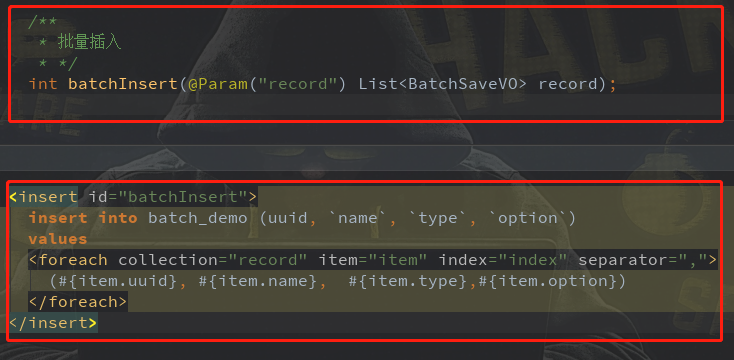7、定时进行数据批处理任务
千里之行,始于足下
正文
一、StopWatch时间控制类:
StopWatch 是spring工具包org.springframework.util下的一个工具类,主要用于计算同步单线程执行时间。
1、StopWatch优缺点:
优点:
(1)、spring自带工具类,可直接使用;
(2)、代码实现简单,使用更简单;
(3)、统一归纳,展示每项任务耗时与占用总时间的百分比,展示结果直观;
(4)、性能消耗相对较小,并且最大程度的保证了start与stop之间的时间记录的准确性;
(5)、可在start时直接指定任务名字,从而更加直观的显示记录结果;
缺点:
(1)、一个StopWatch实例一次只能开启一个task,不能同时start多个task,并且在该task未stop之前不能start一个新的task,必须在该task stop之后才能开启新的task,若要一次开启多个,需要new不同的StopWatch实例;
(2)、代码侵入式使用,需要改动多处代码;
2、StopWatch模板:

public Object stopWatchDemo(){ StopWatch stopWatch = new StopWatch("StopWatch测量业务逻辑的运行时间"); stopWatch.start(); log.info("====================StopWatch计时任务开始========================"); //业务逻辑1 //业务逻辑2 //...... stopWatch.stop(); log.info("====================StopWatch计时任务结束========================"); log.info(stopWatch.prettyPrint()); //打印执行时间 return null; }
二、数据的批处理:
Java中的批处理用于执行一组插入操作或批处理,因为一次又一次地执行单个插入会浪费时间并降低性能。因此,使用批处理可以一次执行多个插入操作,这样可以提高程序的性能。
1、批处理方式一:
@Autowired private SqlSessionFactory sqlSessionFactory; /** * 批处理插入 */ private void upSave1(List<BatchSaveVO> itemList) { SqlSession session = null; try { // 新获取一个模式为BATCH,自动提交为false的session // 如果自动提交设置为true,将无法控制提交的条数,改为最后统一提交,可能导致内存溢出 session = sqlSessionFactory.openSession(ExecutorType.BATCH, false); BatchSaveMapper mapper = session.getMapper(BatchSaveMapper.class); int batchCount = 1000;// 每批commit的个数 int batchLastIndex = batchCount;// 每批最后一个的下标 for (int index = 0; index < itemList.size(); ) { if (batchLastIndex >= itemList.size()) { batchLastIndex = itemList.size(); log.info("index:{}", batchLastIndex); mapper.batchInsert(itemList.subList(index, batchLastIndex)); session.commit(); log.info("index:" + index + " batchLastIndex:" + batchLastIndex); log.info("数据插入完毕"); break;// 数据插入完毕,退出循环 } else { mapper.batchInsert(itemList.subList(index, batchLastIndex)); session.commit(); log.info("index:" + index + " batchLastIndex:" + batchLastIndex); index = batchLastIndex;// 设置下一批下标 batchLastIndex = index + (batchCount - 1); } } session.commit(); } finally { session.close(); } }
2、批处理方式二:
@Autowired private SqlSessionTemplate sqlSessionTemplate; private void upSave2(List<BatchSaveVO> newReports) { SqlSessionFactory sqlSessionFactory = sqlSessionTemplate.getSqlSessionFactory(); // 如果自动提交设置为true,将无法控制提交的条数,改为最后统一提交,可能导致内存溢出 SqlSession sqlSession = sqlSessionFactory.openSession(ExecutorType.BATCH, true); try { Optional.ofNullable(newReports).ifPresent(reports -> { BatchSaveMapper batchMapper = sqlSession.getMapper(BatchSaveMapper.class); batchMapper.batchInsert(newReports); sqlSession.commit(); }); }catch (Exception e){ sqlSession.rollback(); log.error("================保存失败================:{}",e.getMessage()); }finally { sqlSession.close(); } }

3、SqlSessionFactory详解:
(1)、介绍:
SqlSessionFactory是MyBatis的关键字,它是单个数据库映射关系经过编译后的内存镜像,SqlSessionFactory对象的实例可以通过SqlSessionFactoryBuilder对象来获得,而SqlSessionFactoryBuildr则可以从XML配置文件或一个预先定制的Configuration的实例构建出SqlSessionFactory的实例每一个MyBatis的应用程序都以一个SqlSessionFactory对象的实例为核心。SqlSessionFactory是线程安全的,他一旦被创建,应该在应用执行期间都存在,在应用运行期间不要重复创建多次,建议使用单例模式,SqlSessionFactory是创建SqlSession的工厂。
(2)、SqlSessionFactory.openSession()方法:
//新获取一个模式为BATCH,自动提交为false的session // 如果自动提交设置为true,将无法控制提交的条数,改为最后统一提交,可能导致内存溢出 SqlSession sqlSession = sqlSessionFactory.openSession(ExecutorType.BATCH, false);

(3)、ExecutorType三种SQL执行器模式:
1)、ExecutorType.SIMPLE:相当于JDBC的stmt.execute(sql) 执行完毕即关闭即stmt.close()
2)、ExecutorType.REUSE:相当于JDBC的stmt.execute(sql) 执行完不关闭,而是将stmt存入Map<String, Statement>中缓存,其中key为执行的sql模板;
3)、ExecutorType.BATCH:相当于JDBC语句的stmt.addBatch(sql),即仅将执行SQL加入到批量计划但是不真正执行,所以此时不会执行返回受影响的行数,而只有执行stmt.execteBatch()后才会真正执行sql。
|
方式 |
优势 |
劣势 |
|
ExecutorType.SIMPLE |
默认执行器, 节约服务器资源 |
每次都要开关Statement |
|
ExecutorType.REUSE |
提升后端接口处理效率 |
每次一个新sql都缓存,增大JVM内存压力 |
|
ExecutorType.BATCH |
专门用于更新插入操作,效率最快 |
对select 不适用,另外特殊要求,比如限制一次execteBatch的数量时需要写过滤器定制 |
三、定时任务:
1、@Schedule定时任务方式:
在日常开发中比较简单的实现方式就是使用Spring的@Scheduled()注解。但是在修改服务器时间时会导致定时任务不执行情况的发生,解决的办法是当修改服务器时间后,将服务进行重启就可以避免此现象的发生。
(1)、@Schedule详解:
(2)、@Schedule的使用:
要使用@Scheduled注解,首先需要在相关类上添加@EnableScheduling,启用Spring的计划任务执行功能,这样可以在容器中的任何Spring管理的bean上检测@Scheduled注解,执行计划任务。
@Scheduled(cron = "0 0 1 * * ?") public Object batchSaveWay() { StopWatch stopWatch = new StopWatch("@Scheduled定时任务"); stopWatch.start(); log.info("====================@Scheduled定时任务开始========================"); //业务逻辑 stopWatch.stop(); log.info("====================@Scheduled定时任务结束========================"); log.info(stopWatch.prettyPrint()); return null; }
2、SchedulingConfigurer接口线程定时任务方式:
@Schedule 注解有一个缺点,其定时的时间不能动态的改变,而基于SchedulingConfigurer 接口的方式可以做到(例如将cron表达式存入数据库,通过修改数据中的cron表达式,动态改变定时任务的执行周期,而不需要重启项目。)
(1)、操作流程:
1)、声明ThreadPoolTaskScheduler配置类:
@Configuration public class TaskPoolConfig { /** * ThreadPoolTaskExecutor是spring core包中的,而ThreadPoolExecutor是JDK中的JUC。 * ThreadPoolTaskExecutor是对ThreadPoolExecutor进行了封装处理。 * * 拒绝策略: * (1)、CallerRunsPolicy: 当触发拒绝策略,只要线程池没有关闭的话,则使用调用 线程直接运行任务。一般并发比较小,性能要求不高,不允许失败。 * 但是,由于调用者自己运行任务,如果任务提交速度过快,可能导致程序阻塞,性能效率上必然的损失较大 * (2)、AbortPolicy: 丢弃任务,并抛出拒绝执行 * (3)、RejectedExecutionException 异常信息。线程池默认的拒绝策略。必须处理好抛出的异常,否则会打断当前的执行流程,影响后续的任务执行。 * (4)、DiscardPolicy: 直接丢弃,其他啥都没有 * (5)、DiscardOldestPolicy: 当触发拒绝策略,只要线程池没有关闭的话,丢弃阻塞队列 workQueue 中最老的一个任务,并将新任务加入 */ @Bean public ThreadPoolTaskScheduler taskSchedulerExecutor() { // 创建一个线程池对象 final ThreadPoolTaskScheduler scheduler = new ThreadPoolTaskScheduler(); // 定义一个线程池大小 scheduler.setPoolSize(100); // 线程池名的前缀 scheduler.setThreadNamePrefix("taskExecutor-"); // 设置线程池关闭的时候等待所有任务都完成再继续销毁其他的Bean scheduler.setWaitForTasksToCompleteOnShutdown(true); // 设置线程池中任务的等待时间,如果超过这个时候还没有销毁就强制销毁,以确保应用最后能够被关闭,而不是阻塞住 scheduler.setAwaitTerminationSeconds(60); // 线程池对拒绝任务的处理策略,当线程池没有处理能力的时候,该策略会直接在 execute 方法的调用线程中运行被拒绝的任务;如果执行程序已关闭,则会丢弃该任务 scheduler.setRejectedExecutionHandler(new ThreadPoolExecutor.CallerRunsPolicy()); return scheduler; } }
2)、实现SchedulingConfigurer接口:
@EnableScheduling @Component @Configuration public abstract class ThreadSchedulingConfigurerWay implements SchedulingConfigurer { @Autowired private TaskPoolConfig taskPoolConfig; @Override public void configureTasks(ScheduledTaskRegistrar scheduledTaskRegistrar) { scheduledTaskRegistrar.setScheduler(taskPoolConfig.taskSchedulerExecutor()); scheduledTaskRegistrar.addTriggerTask(new Runnable() { @Override public void run() { // 定时任务要执行的内容 executionWay(); } }, new Trigger() { @Override public Date nextExecutionTime(TriggerContext triggerContext) { // 定时任务触发,可修改定时任务的执行周期 String cron = getCron(); //可以将表达式配置在数据库中,动态改变定时的时间 CronTrigger trigger = new CronTrigger(cron); Date nextExecDate = trigger.nextExecutionTime(triggerContext); return nextExecDate; } }); } public abstract String getCron(); public abstract void executionWay(); }
3)、实现定时线程任务:
任务一:
//定时线程任务一 @Configuration public class ThreadSchedulingConfigurerWayOneImpl extends ThreadSchedulingConfigurerWay { @Override public String getCron() { String cron = "0 0/1 * * * ?"; return cron; } @Override public void executionWay() { System.out.println("定时线程任务demo1:" + LocalDateTime.now()+",线程名称:"+Thread.currentThread().getName() + " 线程id:"+Thread.currentThread().getId()); } }
任务二:
//定时线程任务二 @Configuration public class ThreadSchedulingConfigurerWayTwoImpl extends ThreadSchedulingConfigurerWay { @Override public String getCron() { String cron = "0 0/1 * * * ?"; return cron; } @Override public void executionWay() { System.out.println("定时线程任务demo2:" + LocalDateTime.now()+",线程名称:"+Thread.currentThread().getName() + " 线程id:"+Thread.currentThread().getId()); } }
(2)、ThreadPoolTaskExecutor和ThreadPoolTaskScheduler的区别:
3、Quartz框架定时任务方式:
Quartz框架定时任务默认都是并发执行的,不会等待上一次任务执行完毕,只要间隔时间到就会执行,如果定时任执行太长,会长时间占用资源,导致其它任务堵塞。
(1)、添加Quartz依赖:
<!-- quartz定时框架-->
<dependency>
<groupId>org.springframework.boot</groupId>
<artifactId>spring-boot-starter-quartz</artifactId>
</dependency>
(2)、声明Job任务(继承QuartzJobBean抽象类):
@Slf4j public class QuartzBatchSaveJob extends QuartzJobBean { @Autowired @Qualifier("QuartzWay") private BatchSaveService quartzWay; @Override protected void executeInternal(JobExecutionContext jobExecutionContext) throws JobExecutionException { //定时任务的业务逻辑 quartzWay.batchSaveWay(); } }
(3)、编写业务类:
public Object batchSaveWay() { StopWatch stopWatch = new StopWatch("Quartz定时框架启动任务"); stopWatch.start(); log.info("====================Quartz定时框架启动任务开始========================"); //业务逻辑 stopWatch.stop(); log.info("====================Quartz定时框架启动任务结束========================"); log.info(stopWatch.prettyPrint()); return null; }
(4)、将Job任务注册到Spring容器中:
@Configuration public class QuartzConfig { //Quartz定时框架启动任务 @Bean public JobDetail businessJobDetail(){ return JobBuilder.newJob(QuartzBatchSaveJob.class) .withDescription("Quartz定时框架启动任务") .withIdentity(QuartzBatchSaveJob.class.getSimpleName()) .storeDurably().build(); } @Bean public Trigger businessJobTrigger() { String cron = "0 0 1 * * ?"; CronScheduleBuilder cronScheduleBuilder = CronScheduleBuilder.cronSchedule(cron); return TriggerBuilder.newTrigger().forJob(businessJobDetail()) .withIdentity("QuartzBatchSaveJobTrigger") .withSchedule(cronScheduleBuilder).build(); } }




【推荐】国内首个AI IDE,深度理解中文开发场景,立即下载体验Trae
【推荐】编程新体验,更懂你的AI,立即体验豆包MarsCode编程助手
【推荐】抖音旗下AI助手豆包,你的智能百科全书,全免费不限次数
【推荐】轻量又高性能的 SSH 工具 IShell:AI 加持,快人一步
· 被坑几百块钱后,我竟然真的恢复了删除的微信聊天记录!
· 没有Manus邀请码?试试免邀请码的MGX或者开源的OpenManus吧
· 【自荐】一款简洁、开源的在线白板工具 Drawnix
· 园子的第一款AI主题卫衣上架——"HELLO! HOW CAN I ASSIST YOU TODAY
· Docker 太简单,K8s 太复杂?w7panel 让容器管理更轻松!